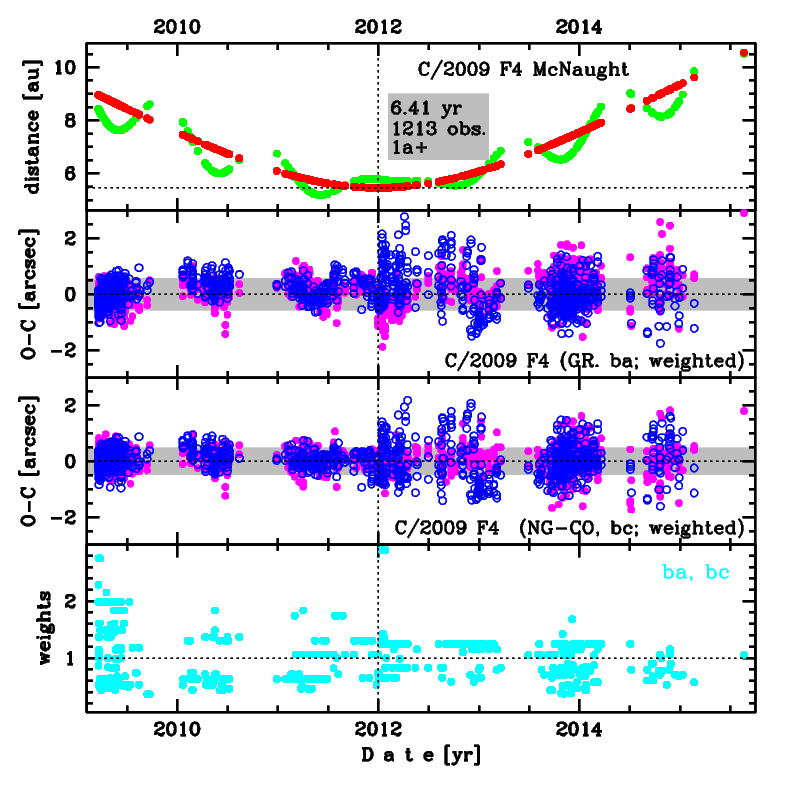C/2009 F4 McNaught
more info
Comet C/2009 F4 was discovered on 19 March 2009, that is 2.8 yr before perihelion passage, and next was observed 6.4 yr during seven oppositions in a range of heliocentric distances: 8.96 au – 5.455 au (perihelion) – 10.5 au.
Comet had its closest approach to the Earth on 3 June 2011 (5.179 au, almost seven months before perihelion).
NG orbits using full data-arc as well as using pre-perihelion data arc are determinable.
This Oort spike comet suffers a tiny planetary perturbations during its passage through the planetary system that lead to a more tight future orbit (see future barycentric orbit).
See also Królikowska and Dones 2023 and Królikowska and Dybczyński 2017.
Comet had its closest approach to the Earth on 3 June 2011 (5.179 au, almost seven months before perihelion).
NG orbits using full data-arc as well as using pre-perihelion data arc are determinable.
This Oort spike comet suffers a tiny planetary perturbations during its passage through the planetary system that lead to a more tight future orbit (see future barycentric orbit).
See also Królikowska and Dones 2023 and Królikowska and Dybczyński 2017.
| solution description | ||
|---|---|---|
| number of observations | 1213 | |
| data interval | 2009 03 19 – 2015 08 20 | |
| data type | perihelion within the observation arc (FULL) | |
| data arc selection | entire data set (STD) | |
| range of heliocentric distances | 8.96 au – 5.46 au (perihelion) – 10.5 au | |
| type of model of motion | NC - non-gravitational orbits for symmetric CO-g(r)-like function | |
| data weighting | YES | |
| number of residuals | 2353 | |
| RMS [arcseconds] | 0.49 | |
| orbit quality class | 1a+ | |
| orbital elements (barycentric ecliptic J2000) | ||
|---|---|---|
| Epoch | 1705 07 22 | |
| perihelion date | 2011 12 31.92137006 | ± 0.00112854 |
| perihelion distance [au] | 5.45158290 | ± 0.00000844 |
| eccentricity | 0.99976743 | ± 0.00000480 |
| argument of perihelion [°] | 260.453021 | ± 0.000135 |
| ascending node [°] | 53.538661 | ± 0.000006 |
| inclination [°] | 79.343056 | ± 0.000012 |
| reciprocal semi-major axis [10-6 au-1] | 42.66 | ± 0.88 |
| file containing 5001 VCs swarm |
|---|
| 2009f4bc.bmi |

Upper panel: Time distribution of positional observations with corresponding heliocentric (red curve) and geocentric (green curve) distance at which they were taken. The horizontal dotted line shows the perihelion distance for a given comet whereas vertical dotted line — the moment of perihelion passage.
Middle panel(s): O-C diagram for a given solution (sometimes in comparison to another solution available in CODE), where residuals in right ascension are shown using magenta dots and in declination by blue open circles.
Lowest panel: Relative weights for a given data set(s).
Middle panel(s): O-C diagram for a given solution (sometimes in comparison to another solution available in CODE), where residuals in right ascension are shown using magenta dots and in declination by blue open circles.
Lowest panel: Relative weights for a given data set(s).
